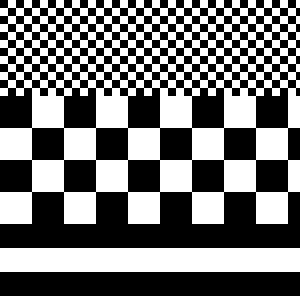 | ||
An image texture is a set of metrics calculated in image processing designed to quantify the perceived texture of an image. Image texture gives us information about the spatial arrangement of color or intensities in an image or selected region of an image.
Contents
- Structured Approach
- Statistical Approach
- Edge Detection
- Co occurrence Matrices
- Laws Texture Energy Measures
- Autocorrelation and Power Spectrum
- Texture Segmentation
- Region Based
- Boundary Based
- References
Image textures can be artificially created or found in natural scenes captured in an image. Image textures are one way that can be used to help in segmentation or classification of images. For more accurate segmentation the most useful features are spatial frequency and an average grey level. To analyze an image texture in computer graphics, there are two ways to approach the issue: Structured Approach and Statistical Approach.
Structured Approach
A structured approach sees an image texture as a set of primitive texels in some regular or repeated pattern. This works well when analyzing artificial textures.
To obtain a structured description a characterization of the spatial relationship of the texels is gathered by using Voronoi tessellation of the texels.
Statistical Approach
A statistical approach sees an image texture as a quantitative measure of the arrangement of intensities in a region. In general this approach is easier to compute and is more widely used, since natural textures are made of patterns of irregular subelements.
Edge Detection
The use of edge detection to determine the number of edge pixels in a specified region helps determine a characteristic of texture complexity. After edges have been found the direction of the edges can also be applied as a characteristic of texture and can be useful in determining patterns in the texture. These directions can be represented as an average or in a histogram.
Consider a region with N pixels. the gradient-based edge detector is applied to this region by producing two outputs for each pixel p: the gradient magnitude Mag(p) and the gradient direction Dir(p). The edgeness per unit area can be defined by
To include orientation with edgeness we can use histograms for both gradient magnitude and gradient direction. Let Hmag(R) denote the normalized histogram of gradient magnitudes of region R, and let Hdir denote the normalized histogram of gradient orientations of region R. Both are normalized according to the size NR Then
Co-occurrence Matrices
The co-occurrence matrix captures numerical features of a texture using spatial relations of similar gray tones. Numerical features computed from the co-occurrence matrix can be used to represent, compare, and classify textures. The following are a subset of standard features derivable from a normalized co-occurrence matrix:
where
One negative aspect of the co-occurrence matrix is that the extracted features do not necessarily correspond to visual perception.
Laws Texture Energy Measures
Another approach to generate texture features is to use local masks to detect various types of textures. Convolution masks of 5x5 are used to compute the energy of texture which is then represented by a nine element vector for each pixel. The masks are generated from the following vectors:
L5 = [ +1 +4 6 +4 +1 ] (Level) E5 = [ -1 -2 0 +2 +1 ] (Edge) S5 = [ -1 0 2 0 -1 ] (Spot) W5 = [ -1 +2 0 -2 +1 ] (Wave) R5 = [ +1 -4 6 -4 +1 ] (Ripple)Sixteen 5x5 convolution masks are then generated as the outer product of pairs of the above masks as follows:
L5L5E5E5S5S5R5R5L5E5E5L5L5S5S5L5L5R5R5L5E5S5S5E5E5R5R5E5S5R5R5S5Autocorrelation and Power Spectrum
The autocorrelation function of an image can be used to detect repetitive patterns of textures.
Texture Segmentation
The use of image texture can be used as a description for regions into segments. There are two main types of segmentation based on image texture, region based and boundary based. Though image texture is not a perfect measure for segmentation it is used along with other measures, such as color, that helps solve segmenting in image.
Region Based
Attempts to group or cluster pixels based on texture properties.
Boundary Based
Attempts to group or cluster pixels based on edges between pixels that come from different texture properties.
